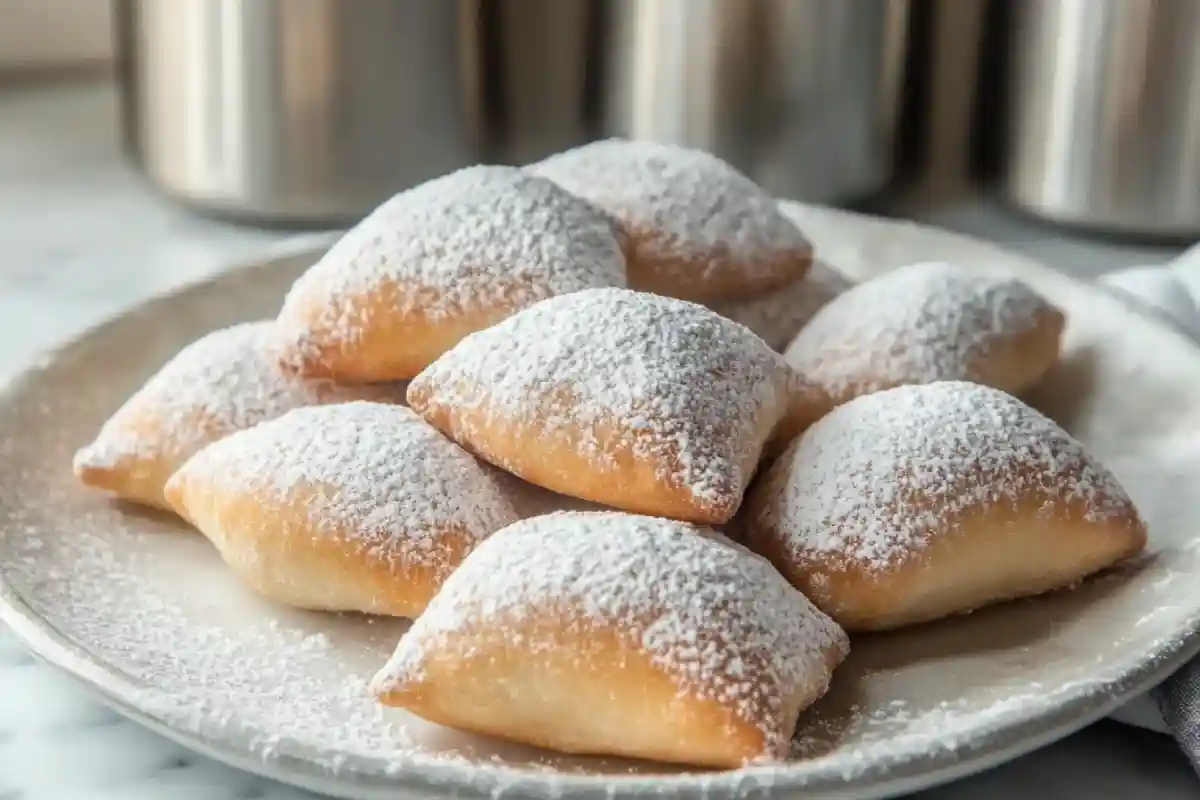
Table of Contents
Craving pillowy beignets without a vat of oil? This baked beignets recipe uses a high-hydration yeast dough and a blast of steam to mimic that airy, hollow crumb—no splatter, no mess. After three sheet-pan trials I locked in a 425 °F bake that puffs in 10 minutes, ready for a snowfall of powdered sugar.
What Are Beignets?
Beignets are a delightful pastry with a long history. Originating in France, they have become a staple in New Orleans cuisine. Traditionally, they are deep-fried until golden brown and generously coated in powdered sugar, creating an irresistible combination of crispiness and softness.
However, while classic beignets are undeniably delicious, frying them in oil can have potential health drawbacks. According to Harvard Health, consuming fried foods regularly can contribute to inflammation and increase the risk of heart disease. This is why many people are now exploring a beignets recipe baked, which offers the same delicious experience with fewer health concerns.
French vs. New Orleans Beignets: What’s the Difference?
Although French beignets and New Orleans beignets share a name, they differ in several ways:
- French beignets are often made with pâte à choux, a light pastry dough that puffs up beautifully in the oven or fryer.
- New Orleans beignets, on the other hand, use a yeast-based dough, giving them a chewy, airy texture.
Both versions can be baked, but the yeast dough requires a slightly different approach to ensure the right balance of fluffiness and flavor.
A Healthier Way to Enjoy Beignets
Switching to a beignets recipe baked not only reduces the amount of oil but also allows the dough’s natural flavors to shine. Since baking doesn’t involve soaking the pastry in hot oil, the final product is lighter yet just as satisfying. If you love Louisiana-inspired dishes, you might also enjoy this baked jambalaya recipe for a healthier take on another classic Southern dish.
By choosing to bake instead of fry, you can enjoy the taste of beignets more often without compromising on health or flavor.
Can You Bake Beignets Instead of Frying?
Many people wonder: “Can you bake beignets?” The simple answer is yes! While traditional beignets are deep-fried to achieve their crispy exterior, a beignets recipe baked provides a healthier yet equally delicious alternative.
Why Choose Baked Over Fried?
Baking beignets offers several advantages:
- Healthier Option – Since baked beignets use little to no oil, they contain fewer calories and less saturated fat.
- Less Mess – Frying can be messy and time-consuming, while baking keeps your kitchen clean and oil-free.
- Easier Preparation – You don’t need a deep fryer, making the process much simpler for home bakers.
How Do Baked Beignets Compare in Texture and Taste?
Although baked beignets won’t have the exact crispiness of the fried version, they still develop a golden-brown exterior with a soft, pillowy inside. To enhance their texture:
- Use a high-temperature oven (375-400°F) for a light, airy result.
- Brush the tops with melted butter before and after baking to add richness.
- Dust generously with powdered sugar for that classic beignet flavor.
Health Benefits of Baking
Switching to a beignets recipe baked isn’t just about convenience; it also supports better heart health. According to Harvard Health, frequent consumption of fried foods can increase inflammation and raise the risk of heart disease. Baking eliminates this concern while still delivering a satisfying treat.
If you enjoy lighter versions of classic Southern dishes, check out this authentic Louisiana jambalaya recipe for another flavorful and wholesome meal idea.
Essential Ingredients for Baked Beignets
A successful beignets recipe baked starts with the right ingredients. Each component plays a crucial role in creating soft, pillowy beignets with a golden-brown finish. Using high-quality ingredients enhances flavor, texture, and overall consistency.
Key Ingredients and Their Purpose
| Ingredient | Purpose | Alternative Options |
|---|---|---|
| All-purpose flour | Provides structure and elasticity | Bread flour for a chewier texture |
| Yeast (active dry or instant) | Helps the dough rise for a light texture | Fresh yeast for a stronger rise |
| Milk (warm) | Adds richness and activates yeast | Almond or oat milk for dairy-free |
| Sugar | Sweetens the dough and aids yeast activation | Honey or coconut sugar for variation |
| Butter (melted) | Enhances flavor and creates a tender crumb | Coconut oil for a dairy-free option |
| Eggs | Binds ingredients and contributes to softness | Flaxseed meal mixed with water for vegan beignets |
| Salt | Balances sweetness and enhances flavor | Sea salt or kosher salt |
| Powdered sugar | Traditional topping for beignets | Cinnamon sugar for extra flavor |
Why Each Ingredient Matters
- Flour provides the structure needed to hold air pockets, giving beignets their signature fluffiness.
- Yeast is essential for creating a light, airy texture by allowing the dough to rise properly.
- Sugar not only sweetens the dough but also helps the yeast activate for an even rise.
- Milk and butter contribute richness and tenderness, ensuring the beignets remain soft inside.
Tips for Ingredient Substitutions
If you have dietary restrictions, you can still enjoy a delicious beignets recipe baked with a few simple swaps:
- Use gluten-free flour with xanthan gum for a gluten-free version.
- Replace sugar with maple syrup for a natural sweetener.
- Opt for coconut milk and oil for a dairy-free alternative.
By choosing the right ingredients, you ensure your baked beignets turn out perfect every time. If you’re looking for more New Orleans-inspired recipes, try this Louisiana dishes collection for more Southern cooking ideas.
Step-by-Step Baked Beignets Recipe
Now that you have all the essential ingredients, it’s time to bring them together to create the perfect beignets recipe baked. Following these steps carefully ensures a soft, airy texture and a golden-brown finish.
Step 1: Preparing the Dough
A well-prepared dough is the foundation of great baked beignets. Here’s how to get it right:
- Activate the Yeast – In a bowl, mix ¼ cup of warm milk with 1 tablespoon of sugar and 2¼ teaspoons of yeast. Let it sit for 5–10 minutes until it becomes frothy.
- Mix the Dry Ingredients – In a large mixing bowl, whisk together 3 cups of all-purpose flour, ¼ teaspoon of salt, and ¼ cup of sugar.
- Combine Wet Ingredients – Add 1 egg, ¼ cup of melted butter, and the activated yeast mixture to the dry ingredients.
- Knead the Dough – Knead for 5–7 minutes until smooth. If the dough feels too sticky, gradually add one tablespoon of flour at a time.
- Let the Dough Rise – Place the dough in a greased bowl, cover it with a clean towel, and let it rise in a warm spot for 1–2 hours, or until doubled in size.
Step 2: Shaping and Proofing the Beignets
Once the dough has risen, it’s time to shape the beignets:
- Roll out the dough on a lightly floured surface to about ½ inch thickness.
- Cut into 2-inch squares using a sharp knife or pizza cutter.
- Place on a parchment-lined baking sheet, ensuring they have space to expand.
- Cover and let them rest for 30 minutes to allow the second rise.
Step 3: Baking to Perfection
Proper baking technique ensures the best texture and flavor:
| Step | Action | Purpose |
|---|---|---|
| 1 | Preheat oven to 375°F (190°C) | Ensures even baking |
| 2 | Brush tops with melted butter | Creates a golden crust |
| 3 | Bake for 12–15 minutes | Allows a soft, fluffy interior |
| 4 | Check for doneness | Beignets should be golden brown |
| 5 | Remove and cool on a wire rack | Prevents sogginess |
Step 4: Finishing Touches
After baking, adding the final touches will make your beignets recipe baked taste even better:
- Dust generously with powdered sugar for the classic beignet experience.
- Drizzle with honey or chocolate sauce for a richer flavor.
- Serve warm with a cup of coffee or café au lait for an authentic New Orleans feel.
By following these steps, you’ll achieve perfectly baked beignets that are light, airy, and just as delicious as the fried version. If you love baked treats, you might also enjoy this homemade muffin recipe for a fun and flavorful dessert option.
Beignets Recipe Baked vs. Fried: Key Differences
Many people wonder whether a beignets recipe baked can truly compare to its fried counterpart. While both versions share the same essential ingredients, their preparation methods result in subtle yet significant differences in texture, flavor, and overall experience.
How Do Baked and Fried Beignets Compare?
To better understand the contrast between the two, let’s break down the key differences:
1. Texture and Crispiness
- Baked beignets have a lighter, bread-like texture with a soft and airy crumb.
- Fried beignets develop a crisp, golden exterior with a slightly chewy interior due to the hot oil.
- Solution: Brushing baked beignets with melted butter before and after baking adds a slight crispiness.
2. Flavor Profile
- Fried beignets absorb oil, creating a richer, more indulgent taste.
- Baked beignets allow the natural sweetness of the dough to shine without added greasiness.
- Tip: Adding a touch of vanilla or cinnamon to the dough enhances the baked version’s flavor.
3. Health Considerations
- Baked beignets contain significantly less fat and fewer calories.
- Frying increases saturated fat content, which may impact heart health.
- Healthier Choice: According to Harvard Health, frequent consumption of fried foods can raise inflammation levels and cardiovascular risks.
4. Ease of Preparation
- Baking eliminates the need for deep-frying, making the process safer and less messy.
- No need for excessive oil, reducing cleanup time.
- Ideal for Beginners: Baking requires less technique than deep-frying, making it more accessible to home bakers.
Which One Should You Choose?
If you crave the authentic New Orleans experience, fried beignets are the way to go. However, if you prefer a lighter and easier alternative, a beignets recipe baked is a fantastic option.
FAQ
Can beignet dough be baked?
Yes, beignet dough can be baked instead of fried. While the texture will be slightly different, baking still produces a soft and fluffy pastry. Brushing the dough with melted butter before and after baking helps mimic the richness of the fried version.
What is the secret to making beignets?
The key to perfect beignets is proper dough preparation. Allowing enough time for proofing ensures a light, airy texture, while using high-quality ingredients enhances flavor. Baking at the right temperature and finishing with powdered sugar completes the classic beignet experience.
What are the three ingredients in beignets?
The three essential ingredients in beignets are flour, yeast, and sugar. Flour provides structure, yeast helps the dough rise for a soft texture, and sugar adds sweetness while aiding in yeast activation.
What is the difference between French beignets and New Orleans beignets?
French beignets are often made with pâte à choux, resulting in a light, airy texture similar to cream puffs. New Orleans beignets, on the other hand, use a yeast-based dough, which creates a slightly chewier and more bread-like consistency.
Conclusion
A beignets recipe baked offers a delicious and healthier alternative to the traditional fried version. While fried beignets have a crisp exterior, baked beignets still deliver a soft, pillowy texture with significantly less oil. By following the right techniques—such as proper proofing, correct baking temperature, and a buttery finish—you can achieve a flavorful, golden-brown treat that feels just as indulgent.
Not only is baking easier and less messy, but it also allows you to enjoy this classic pastry more often without the added fat from deep frying. Whether you are looking for a lighter option or simply prefer the convenience of baking, this method ensures that you don’t have to sacrifice taste or texture.
Now that you know how to make the perfect beignets recipe baked, it’s time to put your skills to the test. Pair your freshly baked beignets with a hot cup of coffee or enjoy them as a sweet breakfast treat. If you’re interested in more Louisiana-inspired baked goods, check out this authentic muffaletta bread recipe to continue your journey into classic Southern flavors.

Beignets Recipe Baked
Ingredients
- 3 cups all-purpose flour or bread flour for a chewier texture
- 2 ¼ tsp active dry yeast or instant yeast
- ¼ cup sugar for sweetness and yeast activation
- ½ tsp salt enhances flavor
- ¾ cup warm milk dairy or plant-based alternative
- 1 large egg room temperature
- ¼ cup unsalted butter melted
- ½ tsp vanilla bean optional for added flavor
- ½ cup powdered sugar for dusting
- 1 tbsp melted butter for brushing after baking
Instructions
- Activate the yeast: In a small bowl, combine warm milk, sugar, and yeast. Let it sit for 5–10 minutes until frothy.
- Mix the dry ingredients: In a large mixing bowl, whisk together the flour and salt.
- Combine the wet ingredients: Add the activated yeast mixture, egg, melted butter, and vanilla bean to the flour mixture. Stir until a sticky dough forms.
- Knead the dough: On a lightly floured surface, knead for 5–7 minutes until smooth and elastic.
- Let the dough rise: Place the dough in a greased bowl, cover with a towel, and let it rise for about 1–2 hours, or until doubled in size.
- Shape the beignets: Roll out the dough to about ½-inch thickness and cut into 2-inch squares.
- Second rise: Place the cut dough on a parchment-lined baking sheet, cover, and let it rest for 30 minutes.
- Bake: Preheat the oven to 375°F (190°C). Brush the tops with melted butter and bake for 12–15 minutes until golden brown.
- Finishing touches: Remove from the oven, brush with additional melted butter, and dust with powdered sugar before serving.
Notes
- To make the beignets even fluffier, let the dough rise overnight in the refrigerator.
- For a crispier texture, bake at a slightly higher temperature for the last 2 minutes.
- Serve warm for the best flavor and texture.

